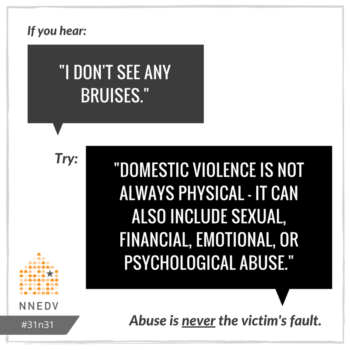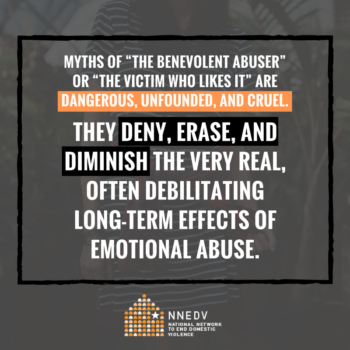Emotional Abuse is Anything but “Tender”: Myths and Reality
November 3, 2016
Emotional abuse is a pattern of behavior used to achieve and maintain power and control over another person by damaging the victim’s self-esteem. [1] Tactics include, but are not limited to: constant criticism; threats; minimizing or blaming the victim for the abuse; isolation from family, friends, or other systems of support; and/or “gaslighting,” or making the victim feel crazy.
Emotional abuse often makes the victim feel responsible for the abuse, yet powerless to change it. It is extremely difficult to recognize, [2] let alone report or prove, and while it may not lead to physical violence, almost all intimate partner violence is preceded and accompanied by emotional abuse. [3] It is important that victims have agency to define their own experiences, and it is equally important to recognize how easily the narrative about emotional abuse can become twisted and glossed over.
Unfortunately, many myths about emotional abuse persist. Myths of “the benevolent abuser” or “the victim who likes it” are dangerous, unfounded, and cruel. They deny, erase, and diminish the very real, often debilitating long-term effects of emotional abuse [4] that victims experience every single day and the choices they are forced to make in order to survive. By calling into question the severity – or even the reality – of abuse, these myths disrupt our ability to hold abusers accountable for their intentional actions; they effectively reinforce the messages the abuser is sending the victim and others.

Another myth about emotional abuse is that aspects of controlling another person can be sexy. Some erroneously believe that emotional abuse is just another form of BDSM (Bondage and Discipline/Domination and Submission/Sadism and Masochism) and perpetuate this confusion. [5] This misconception minimizes the implications of abuse and twists our understanding of BDSM culture; it normalizes controlling, abusive behavior by associating it with a preference that is actually founded in respect. One of the stark differences between abuse and BDSM is a foundation of consent: BDSM includes respect for limits, an understanding of trust, and enjoyment for all partners involved. [6] Abuse does not.
Some mischaracterize emotional abuse as jealousy. Unfortunately, Americans are socialized to believe that jealousy is normal, expected, and encouraged. Constantly calling or checking in is regarded as “thoughtful;” spending excessive amounts of time with one another is “quality time;” feeling romantically threatened by another individual shows how committed a person is to the relationship; and so on. These misconceptions can obscure that such actions are based in a lack of trust and a desire for control of the other person. Abusers are very often “charming” – at first – and their early actions are misconstrued as thoughtful, romantic gestures. We must change the narrative about emotional abuse in a way that allows victims to express their experiences and seek support, and does not minimize or justify abuse.
Emotional abuse is not sexy. It is not tender. It is not an addiction. [7] Some survivors of emotional abuse have expressed to their advocates that they almost wish their abuser had physically hit them – this way others, and they themselves, would know it was abuse and not just normal relationship discord. Emotional abuse may not leave physical scars, but the toll it takes on a victim can be just as detrimental and long-lasting. The confusion emotional abuse creates is very real and just one of many complicated reasons why many victims do not “just leave;” they have false hope that, since they are responsible for the abuse, they can somehow stop it.

Each October, the National Network to End Domestic Violence (NNEDV) honors Domestic Violence Awareness Month (DVAM). This October, NNEDV addressed and dismantled misconceptions about domestic violence through our annual #31n31 campaign, challenging one perception for each of the 31 days of October. [8] These conversations must continue in order to create a world without violence for generations to come.
—
References:
[1] Forms of Abuse https://nnedv.org/resources/stats/gethelp/formsofabuse.html
[2] Goldsmith, Rachel E.; Freyd, Jennifer J. (April 2005). “Awareness for emotional abuse”. Journal of Emotional Abuse. Taylor and Francis. 5 (1): 95–123.
[3] Dutton, Mary Ann; Goodman, Lisa A.; Bennett, Lauren (2000), “Court-involved battered women’s responses to violence: the role of psychological, physical, and sexual abuse”, in Maiuro, Roland D.; O’Leary, K. Daniel, Psychological abuse in violent domestic relations, New York: Springer Publishing Company, p. 197, ISBN 9780826111463.
[4] Packota, Valerie J. (2000). “Emotional abuse of women by their intimate partners: a literature review”. springtideresources.org. Springtide Resources
[5] Upworthy: 6 real quotes from ‘Fifty Shades’ that could make you rethink how you feel about it http://www.upworthy.com/6-real-quotes-from-fifty-shades-that-could-make-you-rethink-how-you-feel-about-it
[6] The Network la Red: What is Abuse http://tnlr.org/en/what-is-abuse/
[7] US Magazine: FKA Twigs Exclusive http://www.usmagazine.com/celebrity-news/news/fka-twigs-emotional-abuse-can-be-tender-kind-of-sexy-w447218
[8] NNEDV’s 2016 #31n31 Campaign https://www.pinterest.com/nnedv/31n31-october-2016/





